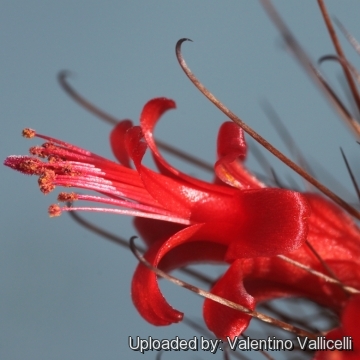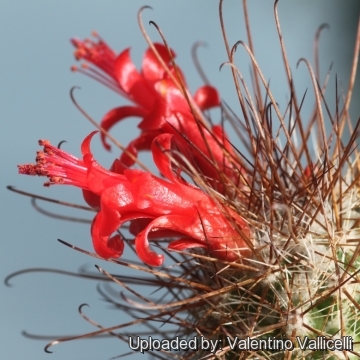Accepted Scientific Name: Cochemiea pondii (Greene) Walton
Cact. J. (London) 2: 51. 1899 , in obs.

Cactus pondii (Cochemiea pondii) Photo by: Valentino Vallicelli
Origin and Habitat: Endemic to Cedros Island, off the Pacific coast of Baja California, Mexico.
Habitat: Grows in non calcareous windswept rocks on slopes and often hanging from steep cliffs, where it grows in association with Agave sebastiana, Echinocereus maritimusSN|8323]]SN|8323]], Mammillaria goodrichii and Ferocactus chrysacanthusSN|12323]]SN|12323]]. The island is frequently shrouded in fog and Pacific, hurricanes can occur year-round.
Altitude: Sea level to 200 m.
Habitat and Ecology: This cactus grows in shrublands on a wide variety of soils, from sandy to rocky slopes. The flowers are very particular, red, narrowly tubular with bilateral symmetry and fit for hummingbird pollination. This is a widespread and common species, with no known decline or threats.
Synonyms:
See all synonyms of Cochemiea pondii
back
Accepted name in llifle Database:Cochemiea pondii (Greene) WaltonCact. J. (London) 2: 51. 1899 , in obs.Synonymy: 3
Accepted name in llifle Database:Cochemiea pondii subs. maritima (G.E.Linds.) U.GuzmánCactaceae Syst. Init. 16: 16 (11 Oct. 2003) first published in U.Guzmán et al., Catálogo Cact. Mex.: 33 (May 2003), without basionym referenceSynonymy: 4
Accepted name in llifle Database:Cochemiea pondii subs. setispina (J.M.Coult.) U.GuzmánCactaceae Syst. Init. 16: 16 (11 Oct. 2003) Remarks: first published in U.Guzmán et al., Catálogo Cact. Mex.: 33 (May 2003), without basionym referenceSynonymy: 5
back
Common Names include:
SPANISH (Español): Biznagita
Description: Cochemiea pondiiSN|9640]]SN|9642]] (syn: Mammillaria pondiiSN|9643]]SN|9643]]) is a small cereus like cactus, at first solitary then with time forming small irregular few branched clusters, with stems, either ascending or prostrate.
Stems: 7-30(-40) cm long, 3-7 cm in diameter, grass green, cylindrical, narrow, either upright or prostrate, eventually clumping near the base of the plant, somewhat jointed hidden under a dense cover of spines.
Tubercles: Conical, axils with fine bristles.
Areoles: Young areoles white and tomentose.
Areoles: At first bearing grey wool then naked.
Radial spines: 15-30 white (usually) creamy or sometime reddish brown, slender, spreading, up to 12 mm long.
Central spines: 4 to 11 up to 30 mm long, reddish, longer and stouter than the radials, of which one (or two) rigid and strongly hooked, whitish with dark tip.
Roots: Fibrous or moderately thickened.
Flowers: Produced near the plants tip from axils of tubercles , long, scarlet, 5 cm long, 2 cm wide, zygomorphic with a long hypanthium, segment flaring and tips reflexed, style as twice as corolla, stamens exerted half as far as style, filaments and anthers red.
Blooming season: March – April (sometime blooms a second time in Autumn)
Fruits: Purplish-red 18 mm long ovoid to obovoid.
Remarks: Cochemiea pondiiSN|9642]]SN|9642]] is often confused with Cochemiea maritimaSN|9642]]SN|9640]] which has only four stouter central spine per areole (of which one hooked).
Subspecies, varieties, forms and cultivars of plants belonging to the Cochemiea pondii group
 Cochemiea pondii (Greene) Walton: (subsp. pondii) has 4-11 central spines up to 30 mm long, reddish, longer and stouter than the radials, of which one (or two) rigid and strongly hooked. Distribution: Cedros Island, off the Pacific coast of Baja California, Mexico.
Cochemiea pondii (Greene) Walton: (subsp. pondii) has 4-11 central spines up to 30 mm long, reddish, longer and stouter than the radials, of which one (or two) rigid and strongly hooked. Distribution: Cedros Island, off the Pacific coast of Baja California, Mexico. Cochemiea pondii subs. maritima (G.E.Linds.) U.Guzmán: has usually only four central spines the lowermost stronger, longer and hooked 3 – 5 cm long. Distribution: Pacific coast of the peninsula Baja California ( from Punta blanca to punta rosalia, west of Punta prieta)
Cochemiea pondii subs. maritima (G.E.Linds.) U.Guzmán: has usually only four central spines the lowermost stronger, longer and hooked 3 – 5 cm long. Distribution: Pacific coast of the peninsula Baja California ( from Punta blanca to punta rosalia, west of Punta prieta) Cochemiea pondii subs. setispina (J.M.Coult.) U.Guzmán: has only 1-4 central spines, upper one straight, lower one longest and hooked, 2-5 cm long. Distributiom: San Borja region, San Julio Canyon, and Angel de la Guarda Island, Baja California.
Cochemiea pondii subs. setispina (J.M.Coult.) U.Guzmán: has only 1-4 central spines, upper one straight, lower one longest and hooked, 2-5 cm long. Distributiom: San Borja region, San Julio Canyon, and Angel de la Guarda Island, Baja California.
Bibliography: Major references and further lectures
1) Pilbeam J., “The Cactus file, Mammillaria” 6: 120, Cirio Pub. Services, 01/Dec/1999
2) James Cullen, Sabina G. Knees, H. Suzanne Cubey "The European Garden Flora Flowering Plants: A Manual for the Identification of Plants Cultivated in Europe, Both Out-of-Doors and Under Glass" Cambridge University Press, 11/Aug/2011
3) David R Hunt; Nigel P Taylor; Graham Charles; International Cactaceae Systematics Group. "The New Cactus Lexicon" dh books, 2006
4) Edward Anderson “The Cactus family” Timber Press, Incorporated, 2001
5) N. L. Britton, J. N. Rose “The Cactaceae. Descriptions and Illustrations of Plants of the Cactus Family.” Volume 4, The Carnegie Institution of Washington, Washington 1923
6) Burquez Montijo, A. & Felger, R.S. 2013. Mammillaria pondii. In: IUCN 2013. "IUCN Red List of Threatened Species." Version 2013.2. <www.iucnredlist.org>. Downloaded on 05 January 2014.
 Cactus pondii (Cochemiea pondii) Photo by: Valentino Vallicelli
Cactus pondii (Cochemiea pondii) Photo by: Valentino Vallicelli Cactus pondii (Cochemiea pondii) Photo by: Valentino Vallicelli
Cactus pondii (Cochemiea pondii) Photo by: Valentino VallicelliCultivation and Propagation: This plant isn't famous for being easy to cultivate, but in good conditions with excellent ventilation, it grows without difficulty. It is especially sensitive to over-watering. So careful watering and an open mineral potting soil are a must. Avoid the use of peat or other humus sources in the potting mixture.
Don't add limestone to the potting mix, which must be moderately acidic. Can be sensitive to frost. Requires maximum sun exposure to reach its full potential. and in order to achieve success in flowering.
A winter rest that allows the plant to shrivel will encourage flowering and long term survival. Be careful to encourage slow growth.
Propagation: Seeds or offsets.












